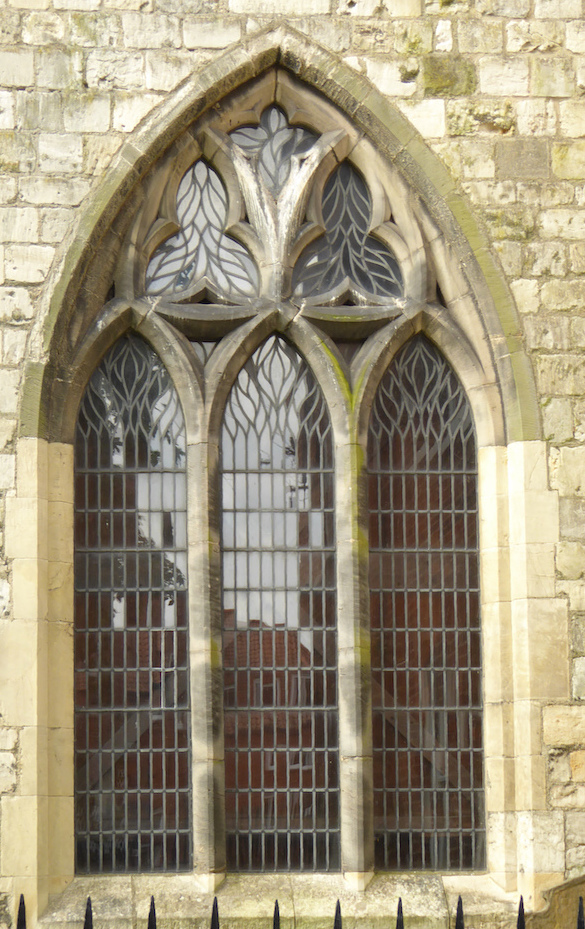Photographs by the author, except where otherwise noted. You may use these images without prior permission for any scholarly or educational purpose as long as you (1) credit the photographer and (2) link your document to this URL, or cite it in a print one. [Click on the images to enlarge them.]

Street view
St Mary, Bishophill Junior is a Grade I listed church on a street called Bishophill Junior, restored by the Atkinson brothers in 1860. Anciently there was another church, St Mary, Bishophill Senior, not far away, but that has been demolished. Bishophill was/is a district of York on the south side of the river in roughly the area were the Roman civil settlement or colonia had been.

View of the east end
The tower of this church is “the oldest piece of ecclesiastical architecture in York” (Pevsner and Neave 171); it is thought to date from the late eleventh century and the tower arch may include Roman material. But the church has plentiful evidence surviving of the Atkinson brothers' approach to restoration. Much of the east end of the chancel was rebuilt in the nineteenth century, also most of the south aisle was rebuilt and the present windows of Decorated type inserted there; the porch was rebuilt, and the south side of the roof was restored with Welsh slate.


Left: The church in 1831 (Wilson and Mee, fig. 86). Right: the South aisle porch.
When this unexceptional restoration work is mentioned in other places (e.g. Pevsner and Neave, and the Inventory), there are frequently quotations of a bad-tempered report in the Ecclesiologist. That journal, after a page of comments on changes at five other old churches in the centre of York – very few of the comments favourable and mostly scathing – there is this short one: “St Mary, Bishophill Junior, York, has just suffered an unintelligent and destructive restoration externally. The churchyard, now closed, has been curtailed to enlarge a street; and the new wall is of the very basest kind” (207)



Left to right: (a) South aisle window on south wall at east end. (b) South aisle East window glazing. (c) Chancel East window.
The windows of the south aisle pre-restoration seem to have been rectangular "secular" ones (Wilson & Mee fig. 86), while the new stone tracery designs for the windows in the south aisle are more attractive and each one differs slightly, in a medieval manner. The glazing to the four windows of the aisle, and to the chancel east window, is mostly monochrome with fluid leaf or flame-like lines in the upper parts, but there is no mention in the listing of this glass, its artist or workshop. The dates of the original stone tracery are given as: the chancel E window c.1300; the S aisle E window c.1330. As far as can be seen from outside, the restoration work to the chancel and south aisle does not seem anachronistic or intrusive.


Left: The much-maligned wall. Right: The late nineteenth-century vicarage abutting the east wall, possibly by the Atkinsons' partner, James Demaine.
The Ecclesiologist was not commenting on work done to the church fabric, but to the boundary wall. The Atkinsons are unjustly condemned for something beyond their control. Even now the street is narrow, with hardly room for two cars to pass; in reducing the churchyard, an old wall was taken down and replaced by another of less height but topped by railings, which were in turn removed, probably during World War II.The brick-built former vicarage abuts the east wall of the north chapel and forms a group with the church; its heritage listing (Grade II), says: “Vicarage, now lodging house; gate and railings attached to front ... banded with 2 courses of blue vitreous brick, and incorporating length of dressed stone wall at left end...." James Demaine (1842-1911) worked for the Atkinson brothers, became a partner and retired in 1899.

A glimpse of the church interior, looking east,
from Plate 130 in the RCHME inventory.
This was a working class area in the nineteenth-century, many no doubt employed in the railway. A nearby factory was designed by Walter Henry Brierley (1862-1926), who joined Demaine in 1885.
Bibliography
"Church of St Mary Bishophill Junior." Historic England. Web. 17 June 2021.
Ecclesiologist. New Series. XIX (1861): 207.
An Inventory of the Historical Monuments in the City of York, South-West, 3, item 8 with phased plan, RCHME. London: HMS0, 1972. 27-30.
Pevsner, Nikolaus, and David Neave. Yorkshire: York and the East Riding. New Haven and London: Yale University Press, 2002.
Wilson, Barbara and Frances Mee. The Medieval Parish Churches of York: The Pictorial Evidence. York Archaeological Trust, 1998. 111-13, fig. 86.
Created 17 June 2021